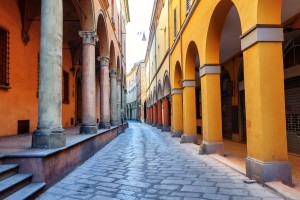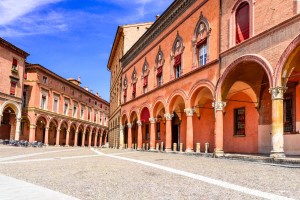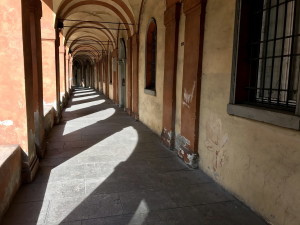Bologna’s abundance of old, mostly excellently-preserved structures makes the city in the Emilia Romagna one of the most popular destinations for art and culture trips. Aside from the imposing medieval towers the porticoes are among the most important means of expressing Bologna’s urban identity. The historic centre alone is covered by more than 38 kilometres of them. Taking the arcades outside the medieval city walls into account, that number climbs to a whopping 53 kilometres. Due to their cultural and artistic significance, twelve representative porticoes of Bologna were given World Heritage status by the UNESCO in 2021. And we invite you to take a closer look at these particularly important porticoes right now.
How the porticoes came about

©Bigstock.com/Boris Stroujko
Porticoes or arcades describe walkways open to one side between one or several buildings in a loggia-like style. A succession of adjoining arcades creates this open side. Porticoes usually grace representative building façades and can even cover entire streets of houses. They were most likely modelled after the cloisters of medieval monasteries. Bologna’s porticoes appeared almost spontaneously in the cityscape of, presumably, the early Middle Ages and were first documented in the year 1041.
The original portico purpose was the creation of additional living space for private buildings. Arcades managed to both facilitate unhindered passage for everyone on public land and create more room for private houses. These structures grew over time successfully braving new architectural challenges. Originally wooden extensions were replaced by support columns over time to prevent the collapse of private structures. A decree issued by the pontifical governor Giovanni Battista Doria and the so-called gonfaloniere (standard bearer, an influential role during the Middle Ages and the Renaissance) Camillo Paleotti on 26 March 1568 demanded the rebuilding of all arcades using brick or stone. This created the world-famous porticoes. However, there are still a few wooden arcades in existence today.
Nine porticoes in Bologna’s historic centre

©Bigstock.com/cge2010
Despite the plethora of porticoes in Bologna the World Heritage commission eventually picked twelve that were – and still are – of special significance. A whopping nine porticoes of Bologna are inside the medieval city walls, and we will introduce you to those now:
- Portici residenziali di Santa Caterina: Some structures saw significant changes during the 19th and 20th century, close to gentrification. The arcades of Santa Caterina and Saragozza, however, didn’t. Installed along several smaller residential houses, they can easily be traced back to their medieval origins even displaying some Gothic characteristics in their narrow composition.
- Piazza porticata di Santo Stefano: Being a part of the Basilica di Santo Stefano and the surrounding structures of the eponymous square, these porticoes pretty much add cohesion to the entire visual constitution extending as far as Palazzo della Mercanzia. Late medieval and Renaissance palaces encounter major religious buildings virtually stitched together by the arcades.
- Strada porticata di Galliera: The porticoes of Via Galliera try to maintain the classic patterns of equally classic buildings where the major infrastructure of the old Roman town used to be. The archetypically old structuring of Palazzo dal Monte and the special reinforcement in the entasis of Palazzo Bonasoni’s support columns represent the erstwhile prestigious endeavours of senatorial families.
- Portico del Baraccano: The connection to the Sanctuary of Santa Maria del Baraccano unites a wealth of 16th and 17th century porticoes in varying heights. The arcades between the sanctuary and Via Santo Stefano are linked together via the so-called Voltone del Baraccano. This vault was supposed to create a visual and spatial connection between the Santuario and the home for poor and orphaned girls.
- Portici commerciali del Pavaglione e dei Banchi: The collision of excellently developed medieval squares and Renaissance remodelling in later times is similarly exquisitely highlighted by particularly long porticoes. Pavaglione, the longest continuous arcade of Bologna, might be the main highlight. The way the arcades of the old university are connected to later structures is impressive as well.
- Portici accademici di Via Zamboni: The collection of porticoes unites several important academic structures such as Palazzo Poggi, Accademia di Belle Arti and Pinacoteca Nazionale di Bologna. Via Zamboni has been representing the city’s student life for over 200 years. The arcades are of equally high symbolic value acting as a dazzling display of the distribution of knowledge on an international level.
- Portici di Piazza Cavour e Via Farini: Two squares, one road, potent structures – a plurality of key arcade buildings comes together along this amalgamation. These porticoes show off particularly well how the redesign efforts of the historic centre during the 19th century turned established basic architectural ideas on their proverbial heads. You get to experience the archetype of the modern arcade design school between Piazza Cavour, Piazza Minghetti and Via Farini.
- Portici trionfali di Strada Maggiore: Already a crucial organisational and transportation axis in Roman times, the Strada Maggiore became a particularly noble “triumphal road” during the Middle Ages. Bologna grew around Strada Maggiore, and its porticoes bear witness to this rapid development. You can still see the medieval origins particularly clearly – perfect to time travel during your city tour.
- Edificio porticato del MAMbo: The ancient bakery only became the MAMbo, Bologna’s museum of modern art, in the 20th Retaining and modernising the old arcade structures was of great importance. This portico represents both the industrialisation and the tentative restoration of former glory while also connecting the most important buildings of the city’s creative and cultural scene.
Three more World Heritage porticoes

©Bigstock.com/Photocritical
However, we’re far from done with our World Heritage round trip. The UNESCO site features another three porticoes situated outside the city walls that most definitely need to be experienced:
- Portico devozionale di San Luca: Bologna is home to several sanctuaries. The one dedicated to the Madonna di San Luca most certainly is of particular beauty. The last part of the pilgrimage road was “upgraded” with this portico, the longest in the world. Several smaller chapels dedicated to the Mysteries of the Rosary punctuate the arcades along the ascending road to the sanctuary. This mostly straight portico is also particularly popular with joggers and walkers, especially in bad weather.
- Portico della Certosa: Another long, straight portico branches off from the one to San Luca near the Certosa cemetery. The portico of Certosa is widely regarded as a unique example of modern arcades with a sepulchral character. It was built after a Napoleonic edict trying to recapture the essence of Roman sepulchral roads. Certosa’s internal arcade structures, however, live and breathe the spirit of the Renaissance.
- Edificio porticato del quartiere Barca: The meeting of classic architectural concepts and modern reinterpretations doesn’t stop at the porticoes of Bologna. An incredibly long piece of evolution of the classic Bolognese arcade extends along the very functional buildings of Treno della Barca. Constant maintenance, more often than not carried out by its residents, keeps the post-modern freshness alive to this day.
Classic and rugged or colourful and modern – the porticoes of Bologna bear witness to eventful centuries and can be neatly explored during extended city tours. They open up some of the most important buildings and sights, and neatly lead to fascinating spots beyond the historic centre. There are many more arcades to discover beyond these twelve World Heritage arcades – just one of many highlights for your next holiday in Bologna.